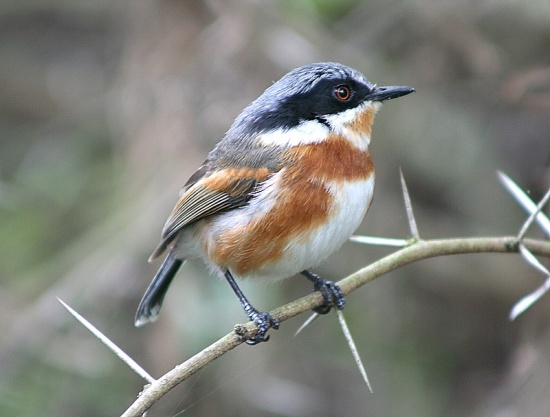- Batis capensis
Identification
Also called Cape Puffbacks, Cape Batises have large heads relative to their small bodies. They weigh 5.1 ounces (13 grams) and are 6 inches (15 centimeters) long. They have short tails, round wings, and orange eyes. Males have dark blue-gray backs and tails, black heads, white throats and bellies edged in reddish brown, and a black breast band. Females have brown heads, a brownish wash over the breast, and no breast band.
Distribution
Southern Africa.
Taxonomy
Sibley & Monroe recognised the Malawi Batis as a separate species. This split from the Cape Batis has, however, not been recognised by Clements or Howard & Moore (Lepage 2007). Recent genetic evidence from a study of the forest Batis species (Fjeldsa, et al., 2006 cited by Percy Fitzpatrick Inst., 2006) indictates that birds from Malawi are closely related to South African birds, but the two populations are sufficiently different to recognise them as separate species. However, birds from Zimbabwe and Mozambique were not included in this study.
Batis capensis has 4 subspecies, variation being mainly in size (northern races larger) and shades of grey and rufous plumage: B. c. capensis from southern and south-eastern South Africa; B. c. hollidayi from eastern South Africa, Lesotho and Swaziland; B. c. kennedyi from the eastern highlands of Zimbabwe and adjascent Mozambique highlands; and B. c. erythrophthalma from the south-central plateau of Zimbabwe.
Habitat
The Cape Batis makes his home in forests, scrub, and planted gardens in southern Africa. Their range is from sea level to 7,050 feet (2,150 meters).
Diet
Like other flycatchers, Cape Batises eat insects and actively seek them throughout the forest canopy by flushing, frightening, them from their places of cover, hiding. The birds then capture their prey as it flies.
Reproduction
This species mates from September to December, building a small cup-shaped nest of dry grasses, held together with spider webs. The nest is built low in thick brush in the fork of a branch and holds one to three eggs. The female incubates, sits on and warms, the eggs for seventeen to twenty-one days. Mating pairs stay together for life.
References
Feldsa J, Bowie RCK & Kiure J. 2006. The Forest Batis, Batis mixta is two species: description of a new, narrowly distributed Batis species in the Eastern Arc biodiversity hotspot. Journal of Ornithology 147, 578-590.
Lepage D. 2007. Avibase. Search for "Cape Batis" downloaded 29 October 2007.
Percy Fitzpatrick Institute. 2006. A new Batis in East Africa. Africa Birds and Birding Vol. 11, No. 6, p26. (Avilable at http://www.fitzpatrick.uct.ac.za/pdf/fitzdj06.pdf)




